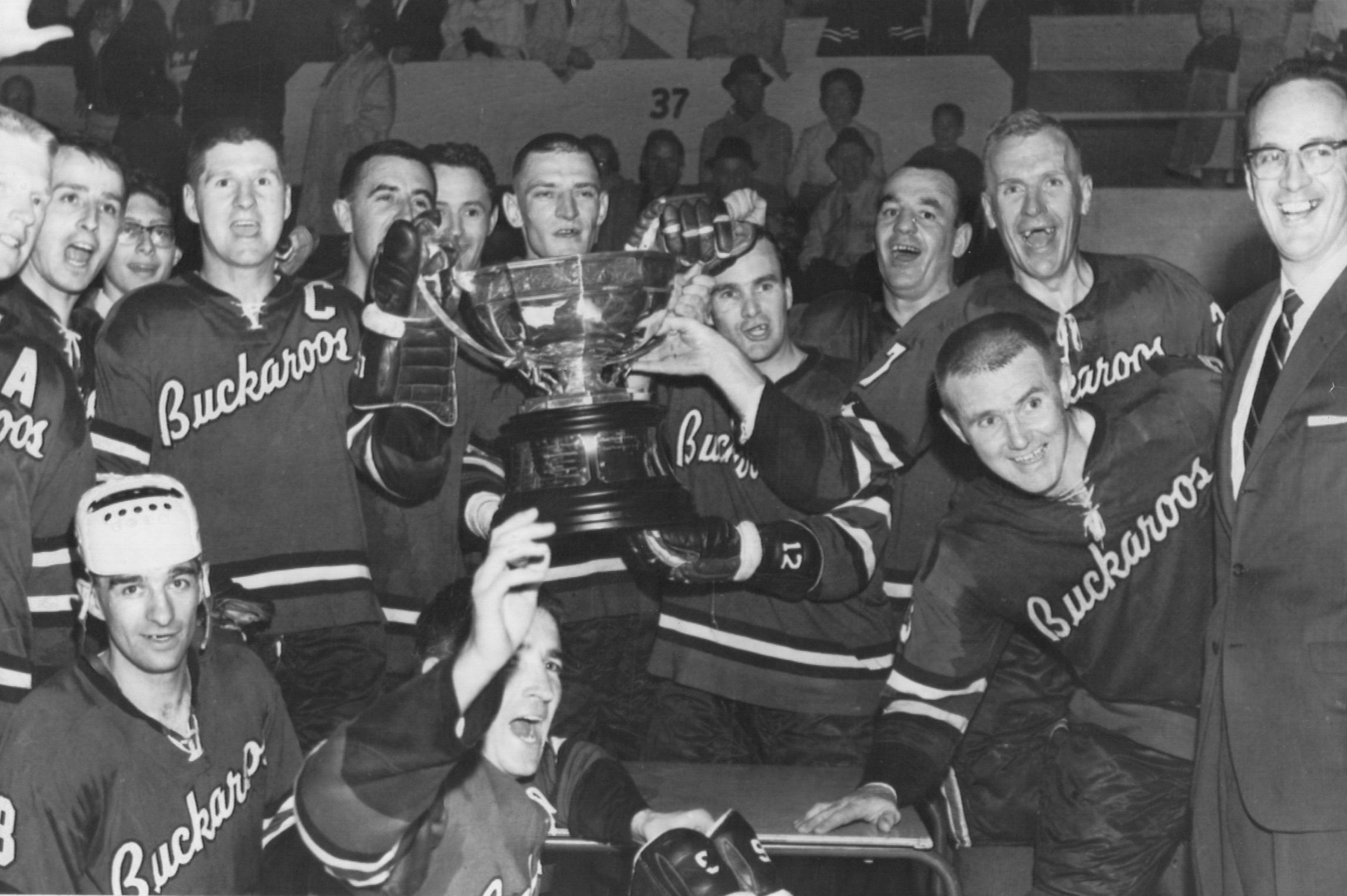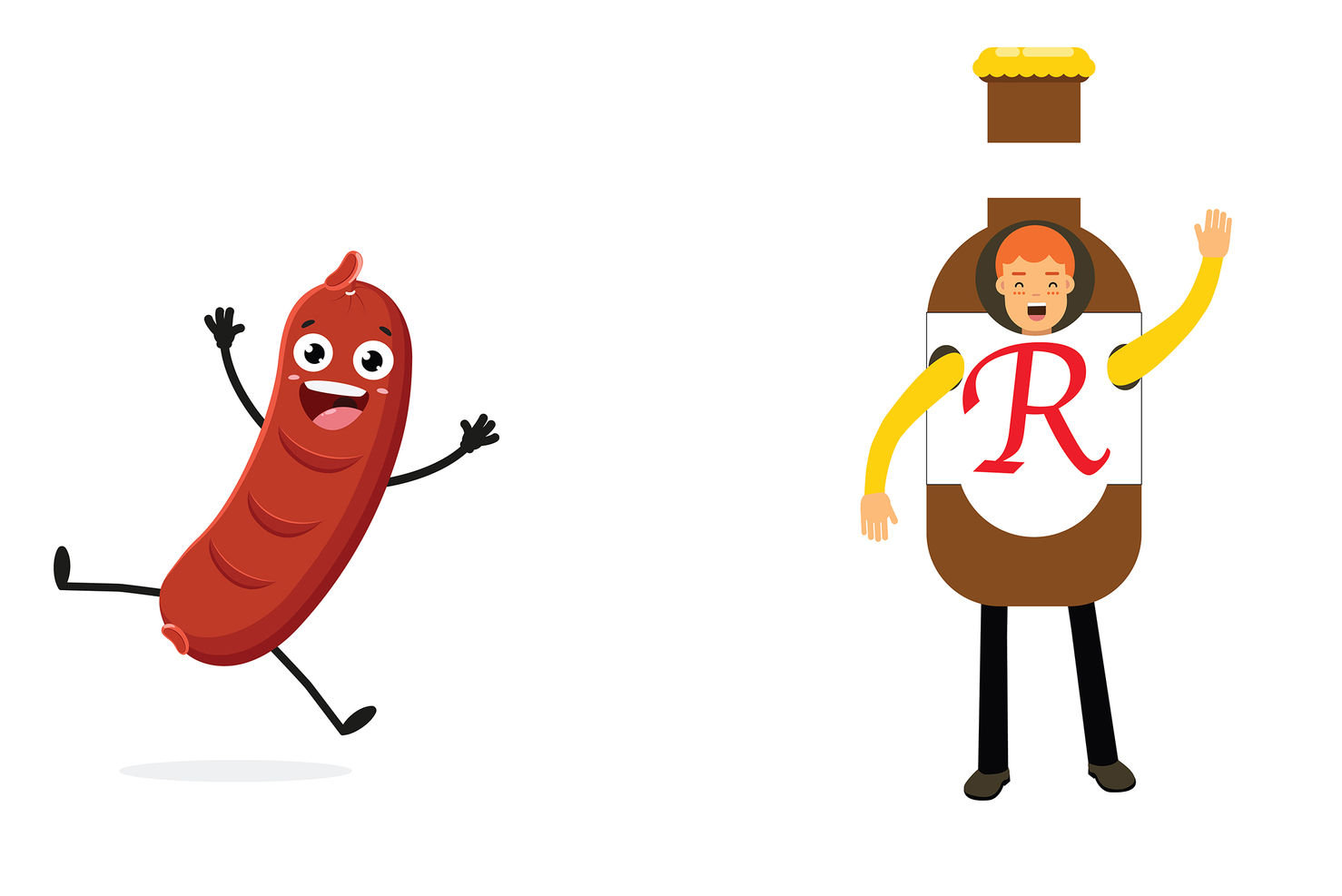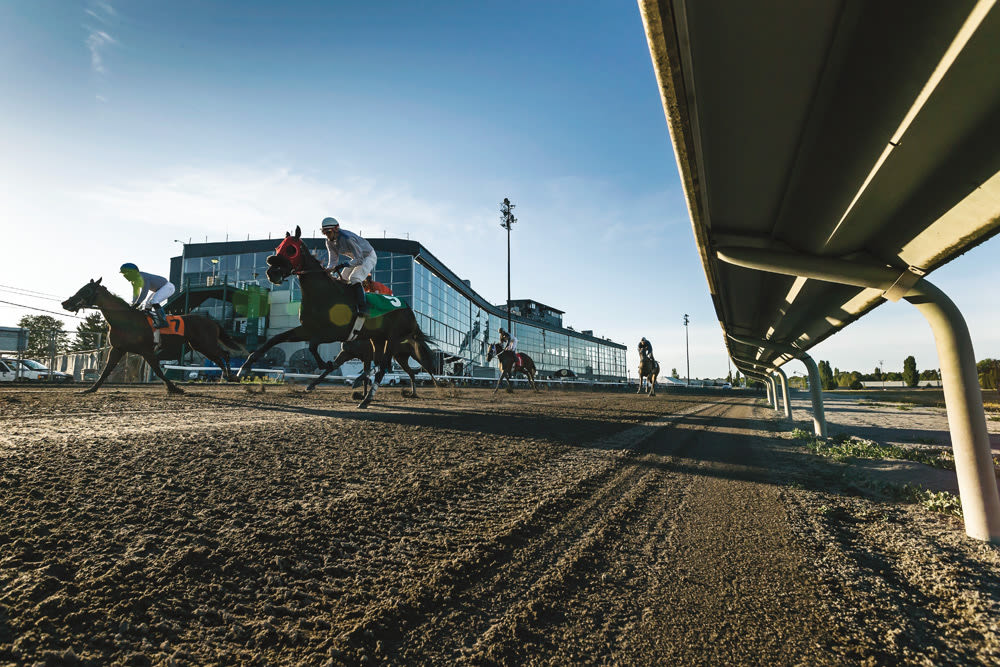
Portland Meadows Gambles on a Comeback
SLIDE SHOW
A Day at the Track
SLIDE SHOW
Portland Meadows: The Jockeys
A gibbous moon hung over a hazy view of Mount Hood one night in late summer, as eight horses trotted out for the evening’s fifth race at Portland Meadows. A few hundred spectators milled alongside the 66-year-old track, many clutching white slips of paper recording bets on the very near future.
A brawny, Washington-bred filly named Giacomina entered the gate as the heavy favorite. But as thousands of pounds of muddy, glistening flesh piloted by tiny, tensed humans barreled down the homestretch, a rival named Fantasyville, born in the horsey heartland of Kentucky, ripped past her. Many of the people along the dirt wall and fence at the edge of the spectators’ area crumpled their white slips. In horse racing’s world of muscular beauty and financial chance, there’s no such thing as a safe bet.
This summer, Portland Meadows took a much bigger gamble on a long shot: itself. Beset by a shrinking local audience and stagnant revenues, Oregon’s only commercial horse track switched from racing in Portland’s muddy winter to running horses in the sun. The track also changed its logo, made over its signature colors, renovated its grandstand, and launched a high-profile advertising campaign featuring atmospheric, antique paintings of horses and jockeys.
“We’ve missed a whole generation,” says Ron Sutton, who owns horses who run at Meadows. “My son is 29, and he’s into it because I’m into it. His friends generally couldn’t care less. We need fresh blood in this game.”
On November 18, Meadows will gauge its progress so far when it hosts Oregon Championship Day, its season’s biggest (and, for victorious horse owners, most lucrative) occasion. If the effort works, the old track tucked into industrial North Portland could become a beacon of hope for an otherwise fading sport. If it doesn’t, people like Sutton, for whom horse racing is a business, a pastime, and often an obsession, could find themselves with nowhere left to run.
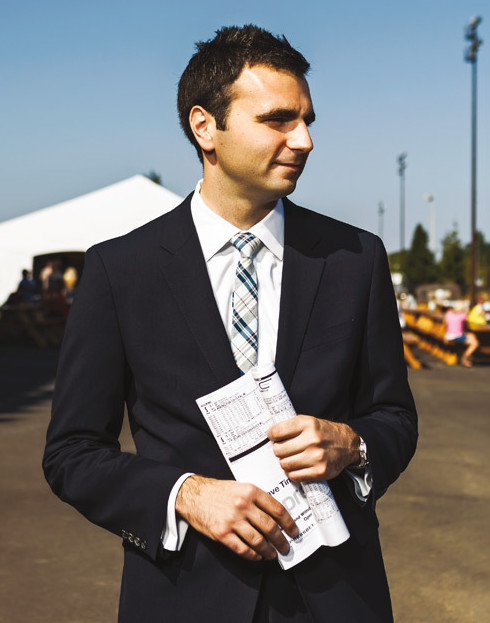
Portland Meadows general manager Will Alempijevic
Image: Daniel Root
When Will Alempijevic was about 5, his dad started taking him to the track in Toronto. A tool-and-dye plant worker from Serbia, his father had discovered fraternity there. “You see Asians over here, guys from the Caribbean over there,” Alempijevic says. “The Eastern Europeans sit together. I’m sure that another Serb took my dad for his first visit, and it just became his social scene.”
Some people get into racing for the camaraderie, others for gambling, others for the animals themselves. As he grew up, Alempijevic gravitated to the vast statistical arcana horses generate as they race. “I learned to read a race program before many more important things,” he says. “How does a horse do on a specific surface? Does the trainer succeed when his horses switch from short distances to long distances? It becomes endless.”
A lanky 33-year-old who wears modish, slim-cut suits and skinny plaid ties at work, Alempijevic (pronounced “A-lem-pee-yevich”) came to Portland to work at Meadows six years ago, dispatched by the track’s Canadian parent company, for which he’d worked at an Ontario track. He became general manager two years later. A cynic might compare this job to running the world’s last vaudeville troupe or steam-engine railway. Horse racing once formed American sports’ macho trinity along with boxing and baseball. (Until after World War II, pro football was almost minor league, pro basketball barely existed, hockey had only six top-tier teams, and soccer was basically for immigrants only.) Local tracks dominated newspaper sports pages and drew huge crowds. When Portland Meadows opened in 1946, more than 10,000 Portlanders turned out and in a single night bet $140,000—over $1.7 million in today’s dollars. The Oregonian lavished coverage on the city’s “brand-new, million-dollar track.”
Except for the tradition-laden Triple Crown races, the sport now resides in a shrinking netherworld of its own. Horse racing has its own nomenclature: a season is a “meet”; race distances are often expressed in furlongs, a unit of measure officially used only in Myanmar. It has its own publications, like the Blood-Horse and Daily Racing Form. The subculture grows ever more remote from mainstream sports. A 2010 New York Times report noted that the “handle”—the total amount bet—for races in New York state is now about one-fifth of what it was in the 1970s, and plummeting.
Meadows doesn’t disclose specific financial information, but Alempijevic doesn’t sugarcoat the situation. “In the six years I’ve been here, we have not made money,” he says. “In fact, our losses have been fairly substantial.”
People who love the sport cite many reasons for its decline, from the suburbanization of ethnic communities to racing’s failure to translate on TV. (“It’s like a play or an opera,” says Gay Welliver, a Meadows horse owner. “You have to see it live, or you just don’t get it.”) Nationally, animal-welfare concerns kick up squalls of bad press. Tracks seldom charge admission and rely almost entirely on gambling revenues, and so must compete with lotteries, casinos, and video poker.
“Racing once had a unique footprint,” says Randy Evers, executive director of the Oregon Racing Commission, the state agency that regulates the sport here. “You came to the track, or you took a cheap flight to Reno.”
Meadows’ business affairs have often reflected racing’s murky prospects. In 2001, a spin-off of the publicly traded Canadian auto parts supplier Magna International added Meadows to a portfolio of tracks that includes Baltimore’s famed Pimlico, home of the Triple Crown’s Preakness Stakes. In 2008, a Washington Post story reported that Magna’s tracks had lost $113.8 million the previous year, when the company had also publicized its desire to sell Portland Meadows. It entered bankruptcy in 2009, and a different spin-off of the same parent company took over the tracks.
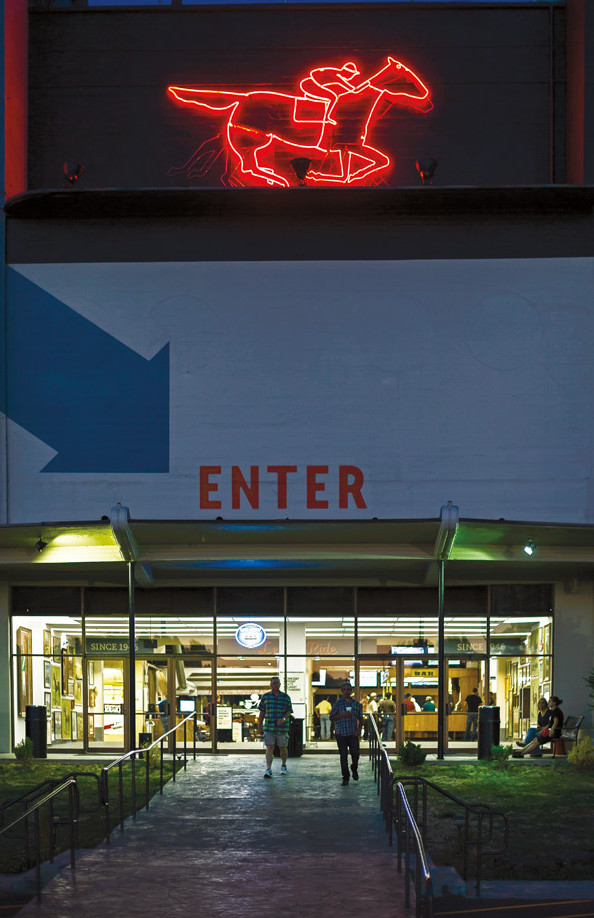
When Portland Meadows debuted just after World War II, it was the nation’s first thoroughbred track to offer nighttime racing.
Image: Daniel Root
Last year, that company transferred the tracks to yet another entity, the privately held Stronach Group, in a complex stock-swap deal. This Toronto-based firm is named for chairman Frank Stronach, a billionaire Austrian-Canadian who founded Magna in the first place and who cuts a prominent, flamboyant figure on the international racing scene. (The 80-year-old Stronach has also started an Austrian political party and owned a Vienna soccer team.) The rearranged ownership has so far been supportive of Meadows—for example, funding $600,000 in capital improvements to the grandstand. However, the Stronach Group, like any for-profit company, cannot brook endless losses.
For the track’s GM, the quest for new revenue faced several obstacles, chief among them Meadows’ dismal winter schedule. But changing seasons was not as straightforward as it sounds. For years, many horses ran in Portland in the winter and at Seattle’s Emerald Downs in the summer. A shift here would force the tracks to compete for both equine and jockey talent. Alempijevic managed to convince both his bosses in Canada and Oregon’s horse owners to make the switch, but many Northwest enthusiasts remain skeptical.
“Overlappin’ don’t work,” says Howard Belvoir, one of the region’s most respected horsemen. Belvoir started training racehorses in 1962 and has competed at both Meadows and Emerald Downs for decades. From his perspective, Alempijevic’s move will damage both tracks, shrinking fields and reducing prize money paid to race winners. “The old arrangement worked for a long time—16, 17 years,” he says. “This is going to be very tough.”
Presenting a more profound challenge, Portlanders seemed to have simply forgotten about Meadows. In the writing of local novelist and songwriter Willy Vlautin, the track figures as a vestige of hardscrabble, blue-collar life. Otherwise, its cultural traction was almost nil.
“When people would ask me where I work, I’d say, ‘At the track,’” Alempijevic says. “And they’d say, ‘Oh, the greyhound track? I thought that closed down.’ I’d say the horse track, and they’d say they thought that closed down, too. You can do market studies or whatever you want. I knew where we stood. We need to be popular. We need people to know who we are.”
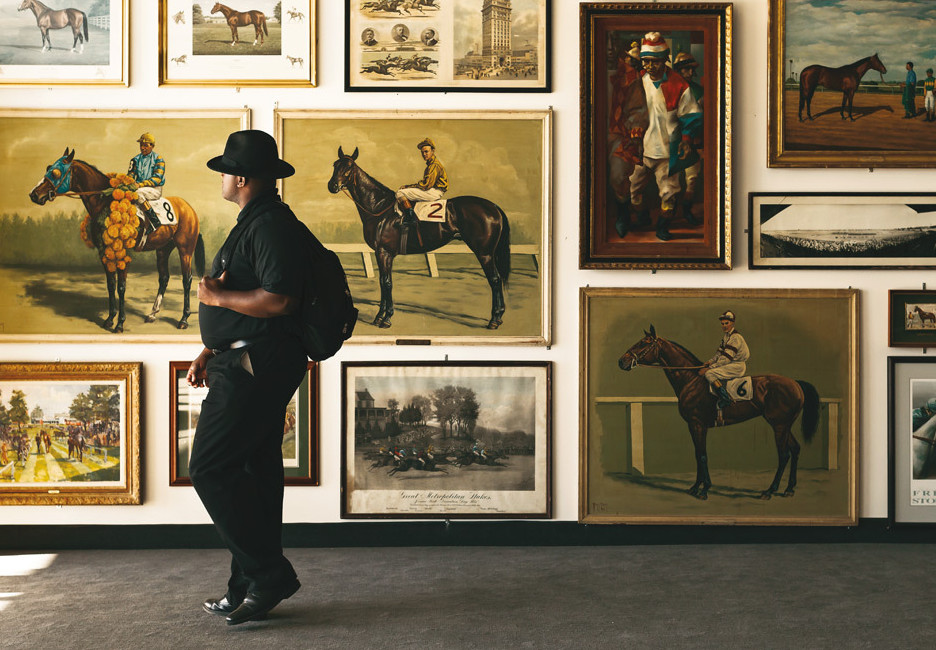
Many of the paintings at the center of OMFGCO’s campaign found their way to Meadows from sister tracks elsewhere.
Image: Daniel Root
If Portland Meadows was a slumbering piece of old Portland, the Official Manufacturing Company—better known by the acronym OMFGCO—has done much to define new Portland. The small creative agency, hatched three years ago by two veterans of the prominent ad firm Wieden & Kennedy, has shaped the graphic design, marketing, and even interior décor of many of the new businesses that mark Portland as an incubator of modern cool. OMFGCO and its principals helped design the identity of the Ace Hotel, packaging for Stumptown Coffee, and the look and feel of Spirit of ’77, a reinvented sports bar near the convention center. The firm has mastered a knowing mix of old and new, refined and scruffy, populist and hip.
“I hadn’t heard of them, but when I looked at what they’d done, I thought, well, yes,” says Alempijevic, who found his way to the firm via referrals. “These are the places I like to go. If these guys can create those images, maybe they can do something for us. They create instantly venerable brands—I don’t know a better way to put it.”
OMFGCO cofounders Fritz Mesenbrink and Jeremy Pelley immediately took to the challenge. “Will told us, ‘Not only are we losing money, but horse racing nationally is losing its audience. We’re going to be gone if we don’t do something. So—hey, no pressure!’” Mesenbrink, a 33-year-old Northwest native, recalls.
On their first visit to the track, OMFGCO’s team stumbled upon a collection of richly colored vintage paintings—a random assortment, of many different ages and origins—depicting classic racing scenes. The agency decided this nostalgic imagery would be its touchstone.
“We took a very brief look at the marketing other tracks do around the country,” Mesenbrink says. “It’s pretty bad. Most of them go for almost generic, modern pro sports branding, and it just doesn’t ring true at all. The real charm of horse racing is definitely old.”
“Those paintings were made decades ago,” Pelley adds. “But the basic look of horse racing has hardly changed—the horses, the jockeys’ silks. That’s not true of any other sport. We wanted to emphasize that classic appeal.”
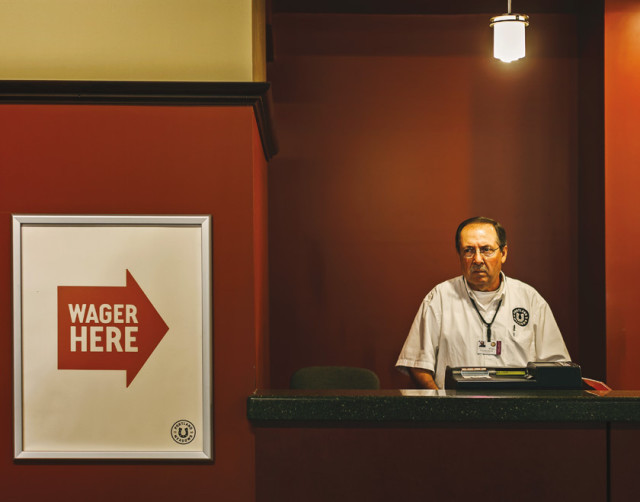
Image: Daniel Root
Last spring, with the summer meet’s July 17 launch just months away, OMFGCO created a stately new color scheme—a rusty orange and “bone”—and a simple new logo featuring an upright horseshoe and “1946,” the year of Meadows’ founding. “Nothing says ‘luck’ like a horseshoe,” Mesenbrink says. “And in a young city like Portland, being around since 1946 means something.”
The firm also custom-made eight small plastic horses and hid them around Portland, dispensing clues to their locations through Portland Meadows’ Facebook and Twitter accounts. People who found them—and, more to the point, snapped and shared photos of them using Instagram, drawing attention to Meadows on social media—entered a contest for $50 gambling vouchers. The firm also dispatched teams of humans wearing rubber horse masks to downtown’s Waterfront Blues Fest and the Mississippi Street Fair to distribute copies of the summer schedule. The citywide advertising campaign, featuring the paintings and the slogan “It’s your lucky day,” hit a few weeks before summer’s first race.
And so the sales pitch became a crosshatch of pictures that would be at home in Granddad’s study, smart graphic design, and ploys aimed at a generation both fluent in status updates and obsessed with bygone style.
Like all trends, the heritage vogue, now a few years old itself, can get a little silly. The world may not need quite as many small-batch moustache waxes or rough-hewn knapsacks as Portland, Brooklyn, and other nouveau old-school bastions now produce. At worst, the trend seems reactionary. At its best, though, it expresses respect for enduring quality. OMFGCO hoped to tap this spirit.
“Technology moves so rapidly, and the population is huge,” Pelley says. “People want real connections and experiences. And it’s just a rare thing to stand with other people so close to so many horses going at top speed. It’s just not like anything else.”
On the first day of the new season, thousands turned out, many of them first-time track-goers. And many of these new potential fans, attracted by OMFGCO’s one-two punch of tweets and classic style, dressed to the nines in the skirts or suits—what they imagined horseplayers might have worn in the glory days of a sport most of them knew almost nothing about.
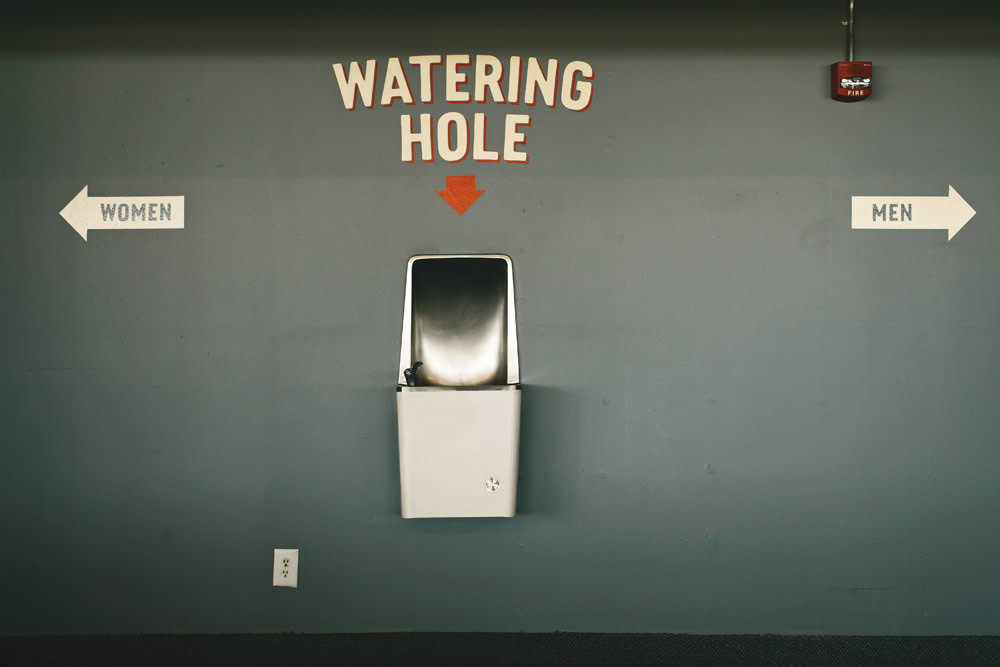
One essential element of OMFGCO’s work: wayfinding signage to help patrons navigate the sprawling track
Image: Daniel Root
To the uninitiated, horse racing might evoke high-life stereotypes, from the wisecracking gamblers of Guys & Dolls to the sheikhs and billionaires who contest the Kentucky Derby. With her jeans, scuffed white tennis shoes, and Nordic-farm-girl features, Gay Welliver fits none of this imagery.
“I don’t own a dress,” the 60-year-old says. “Why would I? I’m in horse barns just about every waking minute.” When she’s not working with her four horses at the track or on her farm south of McMinnville, Welliver and her husband run a sheet-metal business to subsidize their racing passion. “This is the reason my husband gets up in the morning,” she says of the sport.
On a gorgeous day at the very end of summer, Welliver leads me through Portland Meadows’ “backside,” where most of the track’s racehorses live and train during the season. The Meadows complex sits amid the warehouses, gravel pits, and big-box stores that line I-5 just before it crosses into Washington. The backside, however, feels like a throwback to the days when North Portland was a patchwork of farm towns. Horses dwell in a series of low-slung barns, with dirt floors covered with hay and straw, and walls with chipped, crumbling paint. Young Hispanic grooms work with craggy-faced white trainers; wire-muscled women in helmets and safety flak jackets climb astride huge, snorting beasts.
Welliver has run horses at Meadows for about four decades. Her grandfather was, in her words, “a crazy old horseman”; she met her husband in a hay barn. She also serves as president of the Oregon Thoroughbred Owners & Breeders Association, which contracts with the track to provide horses for its races. “The beauty of this sport is astounding,” she says. “Once it bites you, I don’t think there’s a cure.”
She leads the way to a wooden platform overlooking the track’s backstretch. Horses stomp past on practice runs. Welliver explains that on the track, training riders must carefully steer horses in the direction opposite the way they run during races until they’re ready for full-throttle action. Each racehorse is the product of decades of carefully planned equine sex—some bloodlines could theoretically be traced back 300 years—and years of rigorous training. As soon as they’re pointed forward, horses are liable to explode into a sprint.
“They’re geared only for flight,” Welliver says. “The worst horse here trains like an Olympic athlete.”
In horse racing, unlike most other sports, the key piece of equipment breathes, eats, and excretes. Owning even a single racing thoroughbred is a fantastically expensive, idiosyncratic pursuit. “Every horse here has as much as $25,000 sunk into it before it ever runs,” Welliver says. “I just paid $4,000 for oats. I’m going to buy $8,000 worth of hay this fall. I’d show you my tax return, but then I’d have to shoot myself.”
Horsemen recoup by winning race purses. At Portland Meadows, purses tend to range from $3,000 to $5,000 per race, with occasional richer prizes like the $20,000 Don Jackson Futurity Stakes on Oregon Championship Day. “Most horses don’t make any money,” Welliver says. “Maybe every 10 years you get one that bails you out—wins enough that you can pay off your back property taxes, maybe buy a new truck. Maybe I should say that’s the one that keeps you hooked.”

Racing’s aging core audience poses a major concern to those who love the sport.
Image: Daniel Root
Those small potential payoffs rely on a delicate financial infrastructure. Twelve years ago, Oregon became the first state in the nation to license Internet-based horse betting. As a result, several major online gambling operations, known as “hubs,” located here, and currently rake in about $2 billion a year. Those hubs pay around $4.6 million in fees to the state of Oregon. Some of that goes to the general fund. Most, about $2.66 million, goes to “racing development”—i.e., subsidizing the sport. The state bankrolls rural county-fair race meets in places like Burns, Prineville, and Tillamook, where every horseman who competes ceremoniously receives a fat block of cheese.
Meadows receives subsidies, too: Internet gambling fees boost many of the purses the track offers winning horses. As the state’s only commercial track, it anchors the entire racing subculture here. The horsemen and women agree that if the track folds, horse racing in Oregon will almost certainly die. “It’s hard to imagine many people wanting to keep thoroughbreds just to race at county fairs,” Sutton says.
The expenses involved, along with a steady decrease in the number of race days and tracks all across the country, explain why fewer racehorses are born each year. A recent issue of the Thoroughbred Times read with the grim sobriety of a climate-change report: “The number of foals produced annually in North America has declined for seven consecutive years.” (The magazine itself shut down in September.) This year’s total of 22,500 racehorses born depresses Welliver. “I remember crops from the ’70s of well over 50,000,” she says. “The last few years have been devastating.”
As we walk the backside, Welliver points out the preponderance of gray hair. “A lot of people out here are able to do this because they’re on Social Security,” she says. “A lot of other people get up at four o’clock in the morning, come here, then go to their full-time jobs. No one is here for money.”
Welliver sees her little tribe as an embattled remnant of another way of life. “We’ve moved from an agrarian society to an urban society,” she says. “People used to know horses, and be around horses. That has just gone away. And horse racing has never had a national league. We have no NFL. The major sports leagues keep their smaller franchises in the game for the good of the whole. There’s no one out there looking out for Portland Meadows.”
As the horses storm around the track, it occurs to me that if this scene somehow instantly vanished—magically replaced by a profitable big-box franchise with easy highway access, perhaps—few would notice. One could argue that the fate of Meadows, and the passions, trades, and rituals that orbit the track, doesn’t matter much. Few notice when an indigenous language loses its last native speaker, or an obscure creature slips into extinction. In any such case, you don’t know what you had until it’s gone.
“If this track goes out of business, what do I even need a farm for?” Welliver says. “There’s not a person here who’s not holding their breath, hoping this will work.”
As the new summer-to-fall season races to its end, attendance at Meadows is up dramatically, with even quiet race days typically drawing about 1,000 people. “In the winter, we might have had 200 people some days, and half of those would be horsemen,” Alempijevic says. Dollar-beer nights and an infield pool party have made inroads to the younger, plugged-in crowd the track and OMFGCO tacitly targeted.
On the other hand, these new fans wager conservatively. In the summer meet’s first full week, on-site bets amounted to just over $130,000. As of press time, the weekly handle hadn’t hit that level again, with totals of just over $90,000 more typical. That’s higher than most weeks in the now-discarded winter season, but not dramatically so.
Alempijevic and others around the track seem willing to trade a slow financial start for visibility. “I’m absolutely thrilled,” says horse owner Sutton, who also serves as vice president of Horseman’s Benevolent and Protective Association, a charitable group that looks out for people involved in the sport. “I remember days in the ’70s when you couldn’t get a seat in the grandstand, and so I love seeing people out there again.” On some race days, Sutton roams the track wearing a sash marking him as an “ambassador,” placing bets for confused-looking visitors out of a small kitty of money set aside by his organization.
For all of OMFGCO’s clever branding, the critical mechanism for turning new fans into money hides behind a code that’s tough for newbies to crack. The race program’s dense statistics look like sporting calculus on first glance, and bettors can attempt all kinds of fancy combination wagers—exactas, trifectas, and so on—dependent on specific performances by multiple horses.
Alempijevic understands that introducing the sport’s complexities is a major part of his task. “No one is going to place a huge bet the first time,” he says. “They shouldn’t. Our core gamblers tend to be retirees, people with time and money on their hands. But no one is going to become a dedicated horseplayer when they turn 65 if they’ve never seen the sport. It’s like, if you’ve never seen a cricket match, you’re not going to start playing cricket the day you retire.”
Then there is the event itself, which requires an internal shift of gears for the average modern sports fan. Each race takes maybe a minute and a half. With just eight races on the average four-hour program, there’s a lot of time to kill. But it turns out that after one race ends, there’s time to check the program, get a drink, and wander into Meadows’ indoor paddock to inspect the next contestants.
The paddock is Meadows’ real theater: a dramatic, circular space ringed with a transparent wall and a sloped concrete walkway. In the middle, horses are saddled and jockeys mount up in a cluster of little three-walled pens. You can inspect the horses’ ripped haunches, evaluate their demeanor, see which one chooses to unburden its bowels. Then, as the fields head out, there’s time enough to place a bet and maybe get another drink before the race.
Meanwhile, Meadows’ new crowds present one of Portland’s most delightfully mixed-up scenes. White, black, Asian, and Hispanic faces mingle. Cowboy-hat-wearing country dudes work the horses. Leather-skinned gamblers straight from the two-fisted urban world of a Bukowski novel study the program. The rookies attracted by OMFGCO’s campaign stick out in their snappy retro hats and skirts, but add whimsy, style, and raw numbers to the scene.
This may all prove a minor footnote in a once-great sport’s decline. Alempijevic knows he’s trying to invent a new future for racing, not revive lost glory days. “Our track was built when 10,000 people would come out,” he says. “We may never see 10,000 people here again. That’s not defeatist, just realistic.”
On the other hand, 10 years ago few imagined 20,000 Portlanders regularly packing into soccer games. Now the Timbers—buoyed by a bold advertising campaign on which OMFGCO also collaborated—sell out every home match. Fifteen or 20 years ago, almost no one cared where or by whom their beer was brewed; now Portland has more breweries than Munich. As fixed as a culture’s trajectory may seem, a well-timed jolt can change its course.
The Portland Meadows grandstand is divided into two sections, only one of which is currently in use. The double glass doors leading to the closed area are padlocked shut, but you can peer through at an austere but elegant concrete terrace, color-coded benches, and a high, wood-beamed ceiling. “The day I have to unlock that door,” Alempijevic says, “I’ll know we’ve succeeded.”


